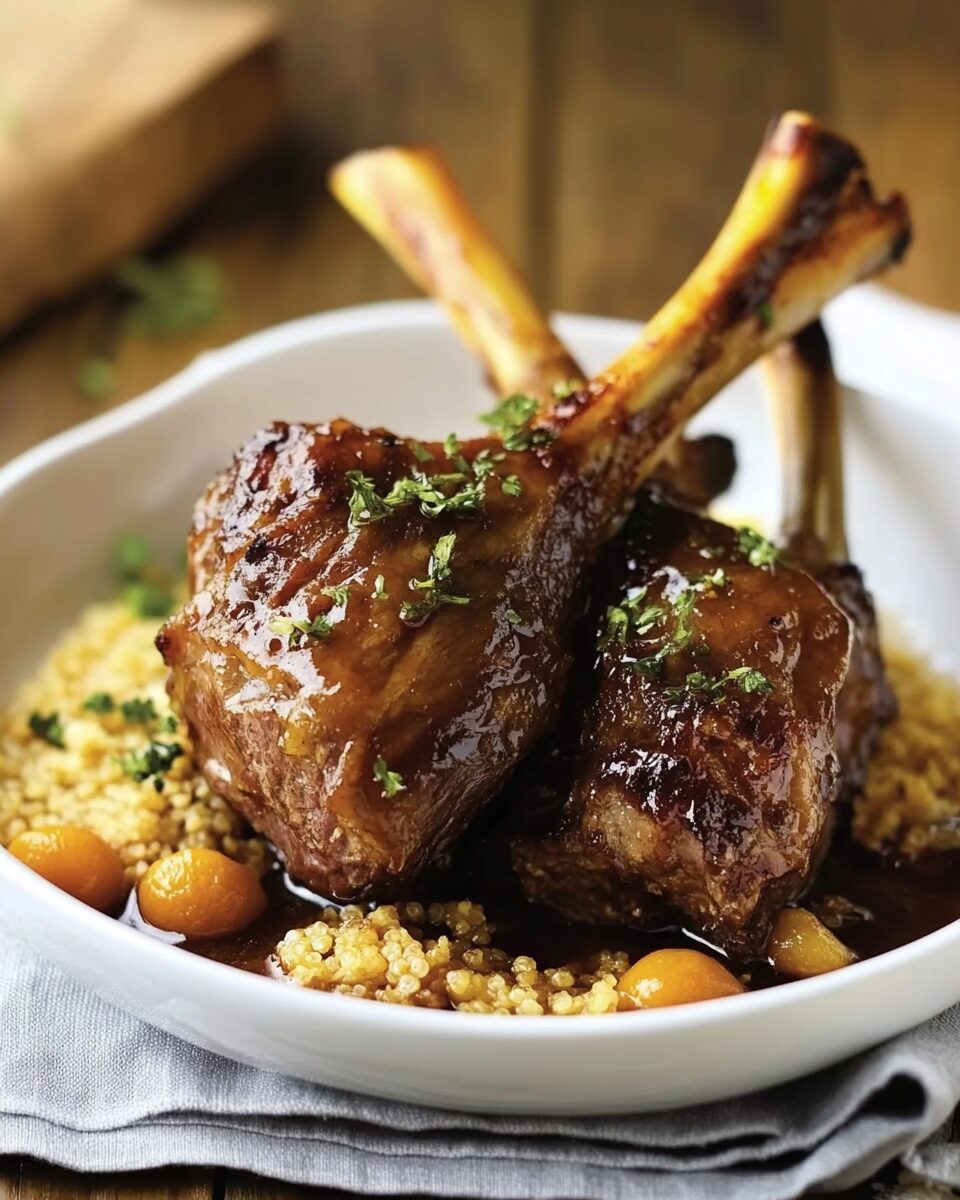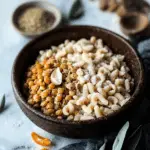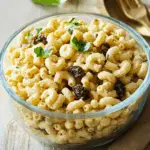A flavorful and tender dish, braised lamb shanks are cooked slowly in a rich sauce of apricot glaze, creating a perfect balance of sweetness and savory depth. The slow braising process ensures the lamb is incredibly tender and infused with the luscious, tangy glaze.
FULL RECIPE
Ingredients
- 4 lamb shanks
- 2 tablespoons olive oil
- 1 onion, chopped
- 2 carrots, peeled and chopped
- 2 garlic cloves, minced
- 1 cup apricot preserves
- 1 cup chicken broth
- 1/4 cup white wine
- 2 tablespoons balsamic vinegar
- 1 teaspoon fresh rosemary, chopped
- 1 teaspoon fresh thyme, chopped
- Salt and pepper to taste
Directions
- Preheat oven to 325°F (163°C).
- In a large ovenproof pot, heat olive oil over medium-high heat. Brown the lamb shanks on all sides, about 8 minutes total. Remove and set aside.
- Add the chopped onion and carrots to the pot, sautéing for 5 minutes until softened.
- Add minced garlic and cook for 1 more minute.
- Stir in apricot preserves, chicken broth, white wine, balsamic vinegar, rosemary, and thyme. Bring to a simmer.
- Return lamb shanks to the pot, ensuring they are partially submerged in the sauce.
- Cover and transfer the pot to the preheated oven. Braise for 2 to 2.5 hours, or until the lamb is fork-tender.
- Remove the lamb shanks from the pot and set aside. Simmer the sauce on the stovetop for an additional 10-15 minutes, until it thickens.
- Season the sauce with salt and pepper, then pour over the lamb shanks before serving.
Nutritional Information
- Calories: 520 per serving
- Protein: 40g
- Fat: 30g
- Carbohydrates: 20g
- Fiber: 2g
- Sugars: 15g
The Best Cuts of Lamb for Braising
When selecting lamb for braising, choosing the right cut is crucial to achieving the perfect dish. Lamb shanks are among the best options for braising due to their rich flavor and tenderness when cooked slowly. The shank is a tougher cut of meat, but it becomes incredibly tender after hours of braising. This method allows the connective tissues to break down, creating a melt-in-your-mouth texture. Other cuts that can be used for braising include lamb shoulder and lamb neck, but lamb shanks are particularly favored for their ability to absorb the flavors of the braising liquid while maintaining a delicious, meaty texture.
How Braising Works
Braising is a cooking technique that involves cooking meat slowly in liquid over low heat, which results in tender, flavorful dishes. The process works by using moist heat to break down the tough fibers of the meat while also infusing it with flavor from the braising liquid. The slow cooking time allows the fat and collagen in the meat to melt, resulting in a silky texture and rich taste. Typically, braising is done in a covered pot either on the stovetop or in the oven, making it a perfect technique for busy days when you need to prepare a meal in advance.
Importance of Marinades in Braising
Marinating lamb shanks before braising can add an additional layer of flavor to the meat. A marinade can help tenderize the meat and infuse it with herbs, spices, and other seasonings. Marinating overnight allows the lamb to soak up the flavors more deeply, but even a few hours of marinating can make a difference. An acidic component such as vinegar or citrus in the marinade helps break down the meat’s fibers, enhancing its tenderness. The apricot glaze used in this recipe serves as both a marinade and a finishing sauce, imparting a sweet and tangy flavor to the lamb.
The Role of the Apricot Glaze
The apricot glaze in this recipe is what sets it apart from traditional braised lamb dishes. Apricot preserves offer a natural sweetness that balances the savory, earthy flavors of the lamb. As the lamb shanks braise, the glaze reduces and thickens, coating the meat in a glossy finish. The fruitiness of the apricot complements the richness of the lamb, while the balsamic vinegar adds a touch of acidity to cut through the richness. This combination of sweet, tangy, and savory flavors creates a harmonious balance that enhances the overall dish.
Using Fresh Herbs for Maximum Flavor
Herbs play an essential role in elevating the flavor of braised lamb. Fresh rosemary and thyme are used in this recipe to add an aromatic touch to the dish. Rosemary imparts a piney, slightly bitter flavor, while thyme offers a mild, earthy note. These herbs complement the rich lamb and sweet apricot glaze, adding complexity to the flavor profile. Fresh herbs are always preferable to dried herbs in braised dishes because they release more essential oils and aromas during the long cooking process, resulting in a more vibrant and fresh taste.
The Benefits of Slow Cooking
Slow cooking is the key to making lamb shanks tender and flavorful. This technique allows the meat to cook gently, breaking down the connective tissue and fat without drying out. As the lamb shanks cook over a few hours, they become so tender that they easily pull away from the bone. The slow cooking process also allows the flavors of the braising liquid to develop and intensify, making the sauce rich and flavorful. This method is perfect for tougher cuts of meat, which would otherwise be chewy and tough if cooked quickly.
Why White Wine Works in Braising
White wine is often used in braising recipes because it adds acidity, depth, and complexity to the dish. In this recipe, the white wine helps deglaze the pot after searing the lamb shanks, lifting any flavorful bits from the bottom of the pot. It also balances the sweetness of the apricot glaze with its crisp acidity. The alcohol in the wine evaporates during cooking, leaving behind a rich and tangy flavor that enhances the overall dish. For this recipe, a dry white wine is recommended, as it won’t overpower the delicate balance of flavors.
Choosing the Right Wine Pairing
When it comes to pairing wine with braised lamb shanks, you want a wine that complements the rich, savory flavors of the dish. A medium-bodied red wine such as a Cabernet Sauvignon, Merlot, or Syrah would pair beautifully with the lamb’s richness. The tannins in these wines help cut through the fattiness of the lamb, while their fruit-forward flavors enhance the sweetness of the apricot glaze. If you prefer white wine, a full-bodied Chardonnay can also be a great choice, as it offers a rich mouthfeel and enough acidity to balance the dish.
The Perfect Side Dishes for Braised Lamb Shanks
Braised lamb shanks are hearty and flavorful, so you’ll want to pair them with side dishes that complement the richness of the meat. Roasted vegetables such as carrots, parsnips, or Brussels sprouts make an excellent choice, as their sweetness balances the savory flavors of the lamb. Mashed potatoes or creamy polenta are also great side dishes that pair well with the sauce, providing a smooth and comforting base to soak up the delicious braising liquid. A simple green salad with a tangy vinaigrette can provide a refreshing contrast to the rich lamb.
How to Store Leftovers
Braised lamb shanks make fantastic leftovers, and storing them properly ensures that they retain their flavor and tenderness. To store leftover lamb, let it cool to room temperature and then place it in an airtight container. It can be stored in the refrigerator for up to 3-4 days. If you want to store it for longer, you can freeze the leftover lamb for up to 3 months. To reheat, simply place the lamb and sauce in a pot over low heat, stirring occasionally, until warmed through. Braised lamb shanks tend to become even more flavorful after sitting in the fridge for a day or two.
What Makes This Dish Special
Braised lamb shanks with apricot glaze is a dish that brings together a variety of flavors and textures in perfect harmony. The tender, melt-in-your-mouth lamb is complemented by the sweet and tangy apricot glaze, while the rich braising liquid enhances every bite. The use of fresh herbs like rosemary and thyme adds a fragrant, earthy element that ties the dish together. Whether served for a family dinner or a special occasion, this dish is sure to impress and satisfy.
The Impact of Braising Time on Flavor
The length of time that lamb shanks are braised greatly affects the flavor of the dish. The longer the lamb cooks, the more deeply it absorbs the flavors of the braising liquid. Braising for two to two and a half hours ensures that the lamb becomes fork-tender and the flavors are well developed. However, if you are short on time, you can braise the lamb for a shorter period, though the meat may not be as tender or flavorful. Slow cooking is essential for achieving the melt-in-your-mouth texture that makes braised lamb so appealing.
The Role of Balsamic Vinegar
Balsamic vinegar plays an important role in balancing the flavors of the apricot glaze. The vinegar’s acidity helps cut through the richness of the lamb, providing a contrast to the sweetness of the apricot preserves. It also adds depth and complexity to the braising liquid, enhancing the overall flavor profile. The balsamic vinegar used in this recipe doesn’t overpower the dish but rather works in harmony with the other ingredients to create a well-rounded and flavorful sauce.
The Appeal of Sweet and Savory Combinations
The combination of sweet and savory flavors is a hallmark of many successful dishes, and braised lamb shanks with apricot glaze is no exception. The sweetness of the apricot preserves balances the savory richness of the lamb, creating a perfect contrast of flavors. This sweet-savory pairing is enhanced by the acidity of the balsamic vinegar and white wine, which cuts through the richness and brings a freshness to the dish. This balance of flavors is what makes the dish so satisfying and delicious.
The Importance of Resting Meat After Cooking
After braising the lamb shanks, it’s essential to let the meat rest before serving. Resting allows the juices to redistribute throughout the meat, ensuring that it remains moist and flavorful. It also gives the braising liquid time to thicken and intensify in flavor. To rest the lamb, simply remove it from the pot and cover it loosely with foil. Let it rest for 10-15 minutes before serving to ensure that the meat retains its tenderness and moisture.
How to Achieve the Perfect Sauce Consistency
The consistency of the sauce is important when braising lamb shanks. The sauce should be thick enough to coat the meat, but not so thick that it becomes overly heavy. To achieve the perfect sauce consistency, allow the braising liquid to reduce after removing the lamb from the pot. Simmer the sauce on the stovetop for an additional 10-15 minutes, stirring occasionally, until it reaches the desired thickness. If the sauce becomes too thick, you can thin it with a little bit of broth or water.
Tips for Searing Lamb Shanks
Searing lamb shanks before braising helps to develop a rich, browned crust on the meat, which adds depth of flavor to the dish. To sear the lamb shanks properly, make sure the pot is hot before adding the meat. Use a generous amount of oil to ensure that the shanks brown evenly. Don’t overcrowd the pot, as this can cause the meat to steam instead of sear. Brown the shanks on all sides for about 8 minutes, then remove them from the pot to prevent overcooking. This searing step is key to developing the rich flavor base for the braising liquid.
Pairing with Roasted Vegetables
Roasted vegetables are an excellent side dish for braised lamb shanks. The natural sweetness of roasted carrots, parsnips, and root vegetables complements the richness of the lamb, while their caramelized edges add texture to the dish. Roasting vegetables brings out their natural sugars, which balance the savory flavors of the meat. The addition of a simple herb rub or a drizzle of olive oil before roasting enhances the flavors, making the vegetables an ideal companion to the tender lamb.
Conclusion
Braised lamb shanks with apricot glaze is a dish that combines rich flavors, tender meat, and a balance of sweet and savory elements. The braising technique allows the lamb to become incredibly tender, absorbing the flavors of the braising liquid while remaining juicy and flavorful. The apricot glaze adds a unique sweetness that complements the lamb’s richness, while the fresh herbs, white wine, and balsamic vinegar create a complex, well-rounded flavor profile. Whether served on a special occasion or a cozy family dinner, this dish is sure to impress and delight.






